
Volume 23 - Spring 2007
The Dating of Gold-Tooled Bindings
by Ian Andrews
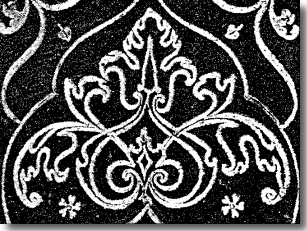
|
Arabic Motif from a Parisian binding of 1540c. The base of the motif is essentially formed from a pair of circular elements and rises at the centre like an onion to a point which is usually embellished with a lotus head. A pair of stems emerge from the embryonic life-form in the base and sweep outwards and on this example are terminated with leaves in the 'Fantasy' style. |
|
'Round
Window' a small section from a Parisian binding of the early seventeenth
century. It shows a small compartment with 'pawls' ornamenting its outer
extremities and a pair of 'snails' at the top and with a 'round window'
feature at its base which also serves to link this element into the main
decorative field.
|
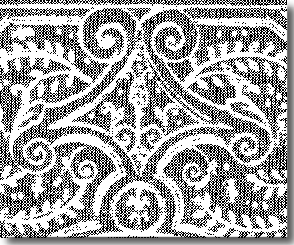 |
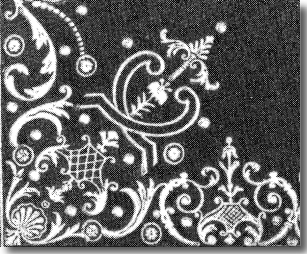 |
Pincers from a French binding of c1766. This shows a number of datable motifs including a scallop shell, strapwork 'pincers', 'swag tailed acanthus leaves and a section of basket weave in the 'Meissen' style. |
|
Tulip
- from an English binding of c1682. This is from a Cottage Roof style
binding and shows a very realistic tulip head on a stylised stem.
|
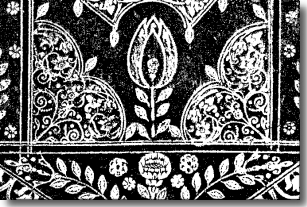 |
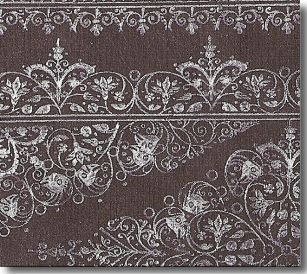 |
Lacy from an English binding of c1670-75 with extremely delicate goldwork giving the appearance of Flanders lace. |
|
Lacy
Dolly - from a Dutch eighteenth century binding showing a central feature
constructed by the imaginative use of four different 'Drawer Handle' tools,
pawls and several lotus heads< color="660033">.
|
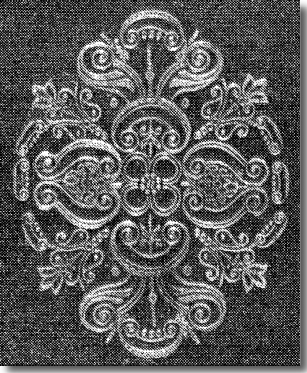 |
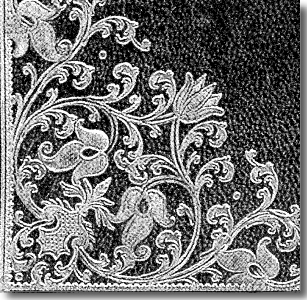 |
Lace 'Applique' - from a Roman binding of the early second quarter of the eighteenth century. The goldwork on this binding closely resembles the style of lacework made at that time in Milan and Turin |
Recent research indicates that significant variations, can be distinguished in the gold-decoration on Western European book bindings, which correlate with the date of binding. The nature of these correlations extends far beyond mere associations with contemporary fashion and appears to be consistent throughout Western Europe. The research, on which this article is based, covered the bindings of Western Europe from 1500 to 1800 and extends from the early phase of major book production to the beginning of the Victorian era when the major enthusiasm in book decoration was nostalgic recreation of previous styles. Prior to the sixteenth century, decoration tended to be based on three main formats. Firstly, rectangular frames, either nesting sets of concentric rectangles or in the style of a 'noughts and crosses' game. Secondly, designs based on either a lozenge or saltire and thirdly, centre and corner designs. Rectangular patterns of repeated small stamps were essentially a Spanish style while the lozenge and saltire constructions are seen on early Coptic bindings. The centre and corners design appears to have been uniquely Christian and is frequently observed on books of the early catholic church where the decoration was achieved with five large cabochon stones mounted on the cover. At the beginning of the sixteenth century, these three styles were well established and the general features of each were the major influences in contemporary design layout. Throughout the sixteenth century, the overwhelming design influence on European bindings is Arabic/Islamic which is perhaps scarcely surprising since it is considered most likely that the use of gold tooling on leather book bindings originated in Italy, carried there by immigrant Jewish craftsmen following their expulsion from Spain at the end of the fifteenth century. At that time too, European trade with the Middle East was the province of the merchants of Italy. Thus Italy was uniquely able to produce books decorated with gold-tooling and was also most thoroughly aware of the styles Arabic art, architecture and textiles.
The major realization from this research has been that in every aspect or feature of a design style or motif, there are subtle changes in its use or appearance that change systematically with time. Thus in such major design styles as 'strapwork' which was one of the most significant design formats from the middle of the sixteenth century right through until the middle of the eighteenth, a span in popularity of two hundred years, seven phases can be distinguished, each being precisely characterised by specific attributes and mutually distinguishable though the phases do not always occur sequentially. Two other overall 'styles' can be similarly resolved into time-variant phases though neither might previously have been thought of as a particular 'design style'. These are Lace and Foliage. The description 'lacy' has, in the past, occasionally been applied to describe the decoration of a particular binding but not only does the description 'lace' appear to be a very appropriate classification for binding decoration but the representation of a great many specific lace design styles in the gilding of bookbindings is often extraordinarily precise. This accuracy of representation extends back virtually to the beginning of the sixteenth century with detailed portrayal of entrelac, cutwork and embroidered lace patterns. It may be therefore that such bookbindings are actually valuable repositories of the patterns of braid, metallic and reticello lace of that time. The precision with which some of the high quality laces such as Brussels, point de Sedan, gros point de Venise and the appliqué laces of Milan and Turin have been represented in the gold-work of bookbindings is particularly astonishing since there is such a difference between the materials employed in the two craft areas, the very fine thread in lacework and the use of heavy metal tools with gold leaf and adhesive on the bookbinding. In the third quarter of the seventeenth century, English and Italian binders captured the ethereal nature of the flimsiest Flanders lace. Designs that portray the characteristics of lace are observed from the beginning of the second quarter of the seventeenth century with the period of greatest usage from 1650 to about 1685 after which it continues at a lesser level and declines rapidly after the middle of the eighteenth century.
By considering the use of flowers and foliage in the decoration of bookbindings in general, it is possible to identify and define many stages in the appearance of leaves, stems and individual flower heads and in addition, the way in which foliage has been used often provides indications of the chronological period of a design. For example during the eighteenth century designs frequently included borders of foliage, usually incorporating many small flower heads. These 'herbaceous borders' appear in very stylised form in the first quarter of the century but are more natural after 1730. From about 1750 to 1780 a very luxuriant form of foliate border is seen that includes some very stylised forms that are very characteristic of this period and may best be described as 'candlestick'. The sixteenth century is a period during which plants and flowers tend to be portrayed in very stylised ways, with the exception of the second half of the century, from 1550 to about 1610, when leaves quite often had the appearance of 'oak leaves' with lots of internal veining, which was unusual for that time. In general the occurrence of small plant forms was most common in the eighteenth century, especially between 1730 and 1790.
Certain flowers experienced periods of particular popularity; daisies for example between 1650 to 1710 and again from 1750 to 1790. The classical 'anthemions', based on the honeysuckle, were popular throughout the eighteenth century but especially so from 1740 to 1780. Acanthus too, was increasingly popular from 1700 and reached a peak between 1740 and 1765 though an earlier version is often observed on sixteenth century bindings. Fantastic leaf shapes were in vogue from 1540 yet had effectively disappeared by about 1565. Amongst all the various flower heads by far the most prolific was the lotus. The lotus head was so widespread, as a decorative motif in the sixteenth and seventeenth centuries that numerous 'standard forms' can be distinguished, the 'Fat' lotus, the 'Paisley lotus, heads with three or five petals, lotus buds on stems, round-bottomed lotus heads and several fork-leaf versions. The similarity of these motifs with those on Islamic architecture strongly indicates that they were acquired from contacts with Arabia through Italian merchants.
In the first quarter of the sixteenth century, a distinctive border decoration was comparatively common and based on a traditional Persian motif consisting of a repeating pair of circles embellished with palm leaves and lotus buds. Designs of the middle of the century, from 1540 to 1565-70 are characterized by the presence of a complex structure that has been described as 'the Arabic motif'. Its presence in book decoration during this time is so prevalent that five distinct versions of it can be defined, all of which occur in much the same time period. These are distinguished as being essentially: geometrical, foliate, 'relaxed' or degenerate types, tall, pinched forms and forms carefully defined within a lotus head outline. From the shape of the Arabic motif and in view of all the details that are included in its complete form, it appears distinctly likely that its design is based on female anatomy and this would coincide with the frequent indication of a tiny new, 'embryonic life' at the centre of almost every bud used in book decoration. This too, links with the eastern mythological connection between life processes and the lotus plant. It is intriguing that the fundamental form of the lotus head has, elsewhere, been described as being 'tulips' despite the fact that the tulip plants were not known in Europe until the early seventeenth century whereas this motif had been in common use for a century before that. In any case, the Turkish tulip which was the origin of the modern tulip was of an entirely different shape and had long slender petals whereas the form that was developed from it in Holland and resulted in the 'tulip mania' of the early seventeenth century were of the same appearance as the modern tulip. Following the European tulip frenzy, very realistic flower heads appear on bookbindings that are unmistakably representations of tulips.
Most often, indications of chronological variation are apparent in the smaller items of a design. Leaves on bindings of 1540 to 1570 often exhibit pronounced notches at their tips. The lotus and the scallop shell are both motifs that are relatively ubiquitous throughout almost these entire three centuries and whose form is constantly changing. Another is a small motif that looks like a tiny vase with two circular handles. The vase appears in the second half of the sixteenth century and continues with numerous variations until the late eighteenth century. The appearance of 'space-filling' treatments, such as snowflakes, triple dots, floating rings and rosettes, akin to the practice known as manière criblée in memorial brass work also convey dateable indications. In strapwork designs for example, very significant sequential evolutions can be distinguished by analysing the precise forms of the linkages and cross-overs. 'Pincer' and 'scissor'-like constructions may often be observed where the strap meets the outer frame. From 1580 to about 1600 a 'round window' is often observed between them and the main strapwork whereas by the later part of the first quarter of the seventeenth century it had become a cross-over linkage. Some motifs appear only for very short periods: the 'spanner lotus' for example in the 1550s, cobwebs in the 1750s, garden path designs and exceptionally long straight stems in the first quarter of the eighteenth century. Another aspect of tooling decoration that shows change with time is the quality of the decoration, meaning the calibre as it were of the draughtsmanship rather than the quality of the gold-tooling. The appearance for example of fan corners and knot-work linkages at the beginning of the eighteenth century are crude as compared to those of the end of the seventeenth.
In an essay as short as this it has not been appropriate, or possible to attempt to provide detailed examples nor to explore the intricacies of occurrence of each feature, style or motif. Rather, I have endeavoured to provide an insight into the generalities of what can be achieved by precise analysis of the gold tooling on bookbindings. I have not been able to mention everything and I have frequently tended to 'state' some of the major findings rather than provide a fully detailed perspective of each entity over the entire period of its usage. Each assertion given here is however, based upon the detailed findings of fastidious analysis. As is probably apparent, I have found this entire subject fascinating both in the ultimate realizations that the fashion for a particular style of book decoration had connections with the most costly fashion fad of the time and secondly the discovery that there are a very significant number of indicators in every design that are surprisingly sensitive to the date when it was bound yet relatively independent of the location where it was bound. In conclusion, I have been able to show that it is not only possible to deduce chronological indications, purely from analysis of the binding decoration, which in favourable circumstances may be to within ten years, but further, that this provides a framework against which it is possible to question, and perhaps revise, the dating of bindings where certain aspects depart from the expected norms.
Ian Andrews previously qualified in physics and is experienced in many areas of scientific research, Ian became very interested in the techniques of fine bookbinding. He attended courses at West Dean College and specialist courses in gold finishing and restoration. His particular interest has been the development of styles of decorative gold design. This article presents a brief summary of some of the results of a major research study on which he has been engaged, to investigate the nature of changes in decorative gold designs with respect to the date when a book was bound.
